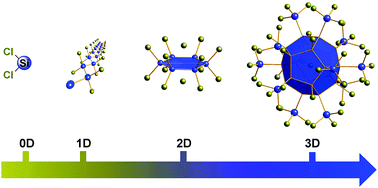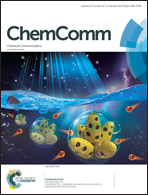Silicon chemistry in zero to three dimensions: from dichlorosilylene to silafullerane†
Abstract
Silylenes and silanides, prominent Si(II) species, are not only interesting in their own right, but also constitute important building blocks in oligosilane and organosilane chemistry. The past decade has witnessed tremendous advances in the understanding of the ambiphilic behavior of silylenes and the nucleophilic properties of silanides, as well as the mutual relationships between both species. Especially the readily available SiCl2/[SiCl3]− system is intriguing, because it features highly functionalized silicon centers, amenable to late-stage modifications. Moreover, SiCl2 and [SiCl3]− are interconvertible by mere chloride association/dissociation. This Feature Article first provides a brief introduction to isolable (functionalized) silylenes and silanides and then focusses on the SiCl2/[SiCl3]− couple. Classical high-temperature protocols for the generation of SiCl2 are juxtaposed with convenient recent solution phase methods that provide access to R3N–SiCl2 and [SiCl3]−via deprotonation of HSiCl3 or the amine-/chloride-induced disproportionation of Si2Cl6. We give a comprehensive overview of key mechanistic issues and highlight the utility of R3N–SiCl2 and [SiCl3]− for the synthesis of open-chain and cyclic oligosilanes as well as nanoscale, fullerene-type silicon clusters.

- This article is part of the themed collection: Philip Power at 65: an icon of organometallic chemistry


 Please wait while we load your content...
Please wait while we load your content...